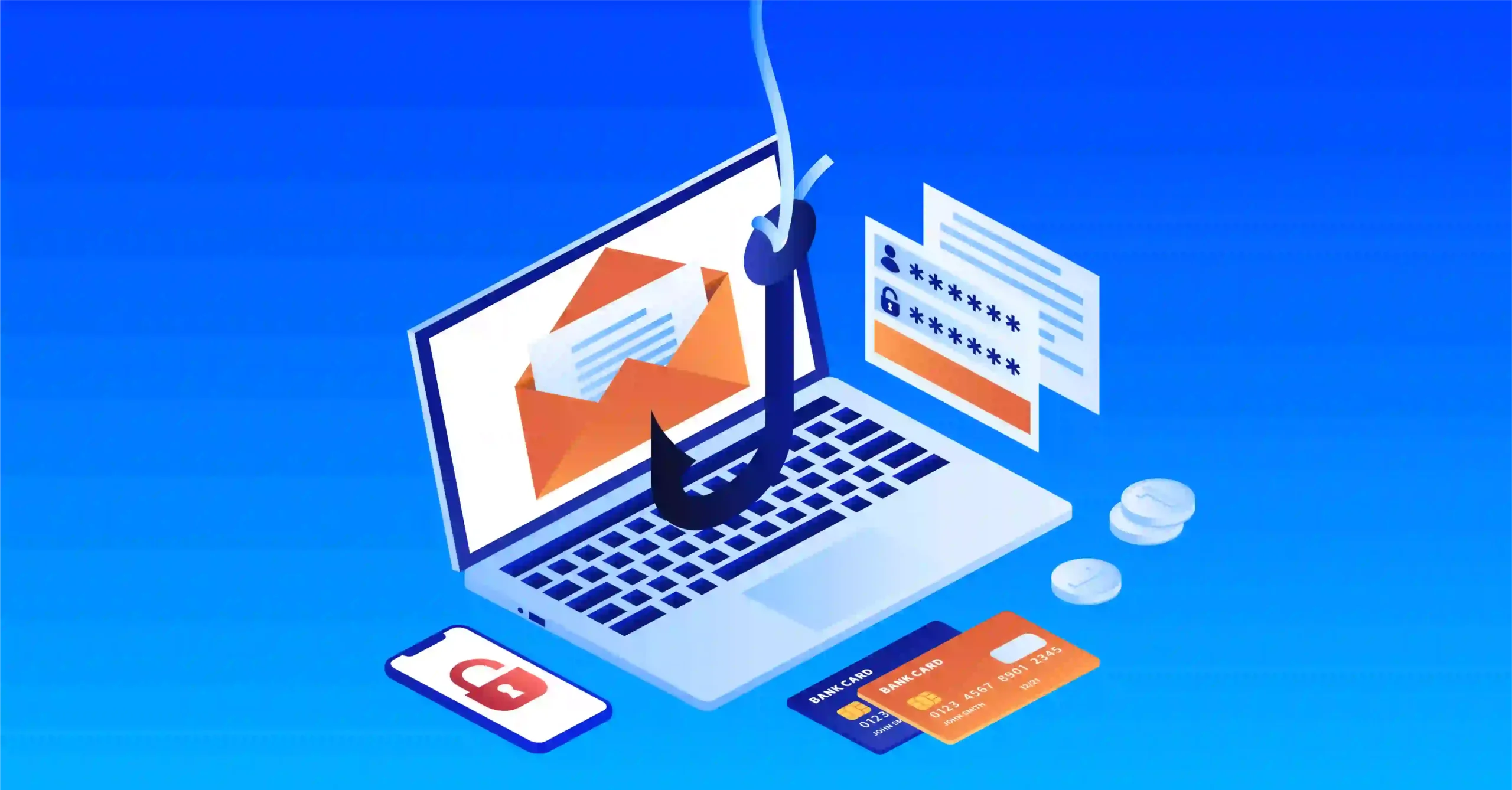What do you think is the most dangerous type of cyber-attack? If you pose this question to a group of individuals, they may have different opinions.
Some would uptick DDOS as the most malicious, while others may consider ransomware as the most effective hacking tool.
However, the stats tell a different story. Phishing remained common out of the millions of cyber attacks last year. According to Cisco, phishing accounted for every 9 out of 10 data breaches last year.
Over the decades, phishing attacks have become more sophisticated, causing more damage to users and online companies.
You won’t allow an unknown person to enter your house, but you can’t stop a spammy email from entering your inbox.
It’s easy to recognize fraud in person, but it’s hard to recognize a fake email or website link. That’s where most users fall prey to phishing attacks.
People often get conned because they don’t know the ins and outs of phishing attacks. Luckily, we have got you covered.
In this article, we have discussed the common types of phishing and how to avoid them. First, let’s take a peek at the definition of phishing.
What is Phishing?
Phishing is one of the most common hacking/ cyber threats that use fraudulent messaging to get PII or personally identifiable information from the victim.
So, basically, it’s tricking someone into providing secret information. These malicious messages can be in emails, SMS, chat messages, website forms, and other data extraction techniques.
They ask the user to click the link and provide the necessary information. Most people fall prey to phishing because the hacker impersonates the interface to make it look legitimate.
Cybercriminals manipulate your pain points and create bait using emotional and psychological triggers.
These baits bring desperate individuals to the trap as they give some personal information such as passwords, credit card codes, and much more.
Hacker- a mysterious, nerdy character- sitting in a dark room, churning out codes mindlessly. That’s the picture we paint when we think of hackers.
We often feel that hackers remain at the back end and use programming to explicit network security. Well, that’s not always true.
Phishing doesn’t necessarily involve coding or programming; it uses social engineering to develop a make-believe posture.
5 Common Types of Phishing You Must Know:
The internet provides a host of ways to connect with individuals worldwide. As rightly said, social media has turned the world into a global village.
You can connect with anyone outside your circle through it. It brings us to the dark side of the internet. Things get frustrating when you connect with someone you don’t know well.
There are tons of ways to initiate a phishing attack. We have covered the 5 most common ones you must know. Knowing them will help you understand these types of cyber-attacks better.
1. Email Phishing:
It is the most common type of phishing used in sales funnels, email marketing, and warm/cold emailing.
As we know, emails are the most common way to market products and services. Almost 80% of the primary customer acquisition is done through email marketing.
Knowing these factors, malicious actors use emails to con common users through phishing. They may ask you to redeem a coupon, download a freebie, or purchase a product at a discount.
Triggering the urgency factor, people click on those malicious links or download malware ebooks on their system.
That said, you can easily identify phishing emails with these tricks.
- Identify the exact names of emails. Often hackers create lookalike emails of a brand. However, they may have some misspelled words. If you find them, avoid clicking on those links or emails.
- You may also track the links to find out if they are legitimate. Try searching for the same offer on google and the actual website. If you can’t find it, your email will likely be phishing.
- You can also identify fake logos. A seemingly real company logo can be fake. It doesn’t look fake, but you can find it on Google Lens. It will find out if the image is on Google or not.
- Recognize the marketing copy. If you are aware of the brand, you may know the tone of copywriting the brand uses. If you find a different brand voice in the email, then stop. There might be something fishy.
Most common practice include is Barrel phishing, that can be difficult to detect, as the emails often look very similar to legitimate messages. This type of attack can be very effective, as even just a few people clicking on the malicious link or attachment can result in a large number of computers being infected.
So, what is Barrel phishing? Barrel phishing is a type of phishing attack that uses mass emailing to target a large group of people. The attacker will send out emails that appear to be from a legitimate source, such as a company or organization, in an attempt to get the recipients to click on a link or attachment that will lead to malware being installed on their computer.
2. Whaling/Boss’s Fraud:
A simpler yet powerful phishing technique that can cause serious damage to an organization is called whaling.
You can also call it corporate fraud. Fraudsters do alot of research on a target. Targeted personnel can be a senior member in a company’s hierarchy that usually handles finance and sales.
Hackers set the groundwork and find the personnel with some weaknesses in the company. Often the communication gap between the employee and the CEO plays its part in tracking the employee.
Thus, the hackers would send an email impersonating the Boss, who would ask for a favor from the employee.
Employees in the corporate sector generally don’t confront or inquire about the Boss. Therefore, they can be easily tricked into performing the act.
The requested favor can be a money transfer to a specific account or information the hacker may need.
You can identify whaling by following these steps:
- You must know bosses don’t communicate through personal emails as an employee. Thus, any intended request may contain malicious objectives if asked through personal emails.
- Do send the email to your immediate Boss to verify its legitimacy. Also, companies create groups to ask joint queries. You can use them to verify those messages.
- Be wary of any message you get that your employer doesn’t ask in general. It may help you grab understand the new behaviors.
3. HTTPS phishing:
HTTPS is often considered a safe protocol; most companies use it in their web addresses instead of HTTP.
Hackers take a more nuanced approach in this regard. To make lookalike links, they use HTTPS protocols now. So, when someone aware of phishing sees the link, they feel that the site is real.
They click on the link to arrive at a malicious website. It can be very dangerous, so users must take precautionary steps to avoid it.
Do you know 49% of malicious websites are now using HTTP, and this trend is growing?
Even you can locate this subtle kind of phishing through these steps:
- Find the URL parameters and identify if it contains any unknown pages. You can easily track the unusual parameters by looking at the web address.
- If the link is shortened, you should avoid it.
4. Vishing:
Vishing stands for phishing activities through phone calls. Fraudsters use phones to call a specific individual and ask them to do a specific task.
The caller may create a sense of urgency and sometimes use fear tricks to accomplish their tasks.
For instance, you get a fake call from an Inland Revenue Department.
The agent asks you to pay your taxes as immediately as possible or show your credentials. Such calls are often phishing calls and should be avoided.
To identify vishing calls, follow these points:
- You might be a victim of phishing calls if your caller number is unusual or doesn’t have incoming calls.
- It might be fake if the caller is in haste and asks you to provide PII.
- Most Govt numbers are open to everyone. People recognize them. If you get a call from an unexpected number, then there might be something fishy.
5. Clone Phishing:
As the name suggests, it usually clones an already-running online business and copy-pastes the services or products you want.
After thorough research, the hacker finds you interested in that service and sends you emails impersonating that service.
For instance, you subscribe to a service and get a welcome message asking you to download some attachments.
Clone phishers use this technique to create email messages containing attachments. When you download those attachments containing ransomware, your website gets hacked.
You can become aware of such phishing techniques through this process:
- Often the cloned messages are poorly written and often copy-pasted. So, while reading the message, you know if it’s real or fake.
- If the message asks you to provide personal information, it may be malicious because marketing emails do not generally ask for PII.
5. Barrel Phishing:
It can be difficult to detect, as the emails often look very similar to legitimate messages. This type of attack can be very effective, as even just a few people clicking on the malicious link or attachment can result in a large number of computers being infected.
So, what is Barrel phishing? Barrel phishing is a type of phishing attack that uses mass emailing to target a large group of people. The attacker will send out emails that appear to be from a legitimate source, such as a company or organization, in an attempt to get the recipients to click on a link or attachment that will lead to malware being installed on their computer.
To protect yourself from barrel phishing attacks, it is important to be aware of the signs that an email may be malicious. Be suspicious of any email that contains a link or attachment, even if it appears to be from a legitimate source. If you are unsure about an email, you can always contact the sender directly to confirm that it is legitimate. Additionally, make sure that your computer has up-to-date antivirus software installed, as this will help to protect against any malware that may be installed through a barrel phishing attack.
How to Avoid Phishing Attacks?
Phishing attacks, no doubt, prevail nowadays. Alot of people get conned through these attacks. However, you can identify and avoid them.
Train your employees:
CEO Fraud and Spear Phishing are very common nowadays. To avoid them, you need to train your employees with up-to-date techniques.
Hackers have developed new social engineering tactics to fraud personnel into providing or taking action that can cause damage to the company.
However, training the employees can pre-empt any potential threat to the company resources. The DuckDuckGo experiment is a pertinent case in point.
They experimented with a fake phishing attack on their employees by sending them discount offer emails. Those who clicked the emails were redirected to cyber security and phishing training and courses.
Use exact email filters:
Email filters are a great way to get the right emails to your inbox. It provides a convenient way to avoid overcrowded inboxes with unnecessary and spam emails.
An often avoided benefit of spam filters is that you can specify and even remove malicious emails from your inbox.
Phishing emails contain malware in attachments such as ebooks and pdfs. Filters will detect these emails and give you access to important emails.
Install web alters plugins:
Thanks to the advancement in security and data protection, you can now use different plugins on your website that give you alerts of potential threats. Besides plugins, there is also an SSL certificate option in which a few recommended certs, which are popular in the industry. For example, RapidSSL wildcard (for subdomains), Comodo PositiveSSL wildcard for unlimited subdomains, Sectigo wildcard, etc. should be there to avoid data spying.
Also, you can use web extensions to detect any website containing malware. Through these alerts, you can immediately skip the websites containing malware.
Can VoIP Help In Avoiding Phishing Attack?
VoIP can contribute to the avoidance of phishing attacks by incorporating security features such as encrypted communication, two-factor authentication, and voice recognition. Encrypted VoIP calls enhance the confidentiality of conversations, making it more challenging for attackers to intercept sensitive information. Two-factor authentication adds an extra layer of user verification, mitigating the risk of unauthorized access. Voice recognition technology can enhance security by providing a unique and difficult-to-replicate identifier. Although VoIP alone cannot entirely prevent phishing attacks, its integrated security measures significantly bolster overall defenses, and combined with user education on recognizing phishing attempts, it can create a more resilient communication environment.
Final Words:
Phishing attacks are the most common types of hacking attacks nowadays. Though they may seem like simple tricks to steal data from people, they can cause serious damage.
Knowing the importance of these threats, we have addressed five types of phishing attacks you can likely face. Plus, we have provided some precautions to avoid them.
If you have gone through the article, let us know your feedback.




